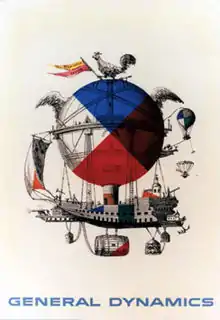Erik Nitsche
Erik Nitsche (September 7, 1908 – November 10, 1998) was a pioneer in the design of books, annual reports, and other printed material that relied on meticulous attention to the details of page composition, the elegance of simple type presentation, and the juxtaposition of elements on a page. His hallmarks were impeccably clear design, brilliant colors, smart typography, and an adherence to particular geometric foundations.

Biography
Erik Nitsche was born in Lausanne, Switzerland on September 7, 1908 and studied at the Collège Classique of Lausanne and the Kunstgewerbeschule in Munich. Prior to immigrating to the United States, he was a designer for Simplicissimus, Jugend, and Der Querschnitt, creating covers and illustrations. He moved to the United States in 1934, where he worked in Hollywood before moving to New York in 1936. In New York, he worked for major magazines including Life, Vanity Fair, and Harper’s Bazaar as well as advertising and promotional campaigns for Twentieth Century Fox and Universal.[1]
In 1955, Nitsche began working with engineering company General Dynamics as art director, which he held until 1960. He designed a breakthrough series of posters, in addition to designing their corporate image, annual reports, and advertising through the development of information design systems.[2] Nitsche designed a 420-page book on the company's history entitled Dynamic America, prompting him to begin designing his own books.[3]
Nitsche was also a consultant to the Museum of Modern Art's department of design and to Standard Oil of New Jersey in the 1950s and 60s.[2]
In the early 1960s, Nitsche moved to Geneva where he established ENI, S.A. (Erik Nitsche International) and designed two encyclopedias: The New Illustrated Library of Science and Invention with 12 books in the setand the History of Music with 20 books in the set. ENI folded after Nitsche's former partner established a similar company designing similar books, leaving him in debt.[4] 1965 to 1980, Nitsche lived in Paris where he produced over 2,000 color illustrations for the five-volume encyclopedia, L’Épopée Nationale d’un Siècle, which covered 100 years of science and technology.[1][2][5]
In 1981, he moved back to Munich, returning to the US in 1996. Nitsche died on November 10, 1998 in Danbury, Connecticut.[1][2]
References
- "Erik Nitsche". ADC • Global Awards & Club. Retrieved 2019-05-30.
- Heller, Steven (1998-11-29). "Erik Nitsche, 90, Modernist Graphic Designer". The New York Times. ISSN 0362-4331. Retrieved 2019-05-30.
- Clifford, John (2014). Graphic Icons: Visionaries who Shaped Modern Graphic Design. Pearson Education. ISBN 9780321887207.
- Heller, Steven (2011-11-22). "Erik Nitsche, Design Auteur". Print Magazine. Retrieved 2019-05-30.
- "Erik Nitsche | Biography | People | Collection of Cooper Hewitt, Smithsonian Design Museum". collection.cooperhewitt.org. Retrieved 2019-05-30.